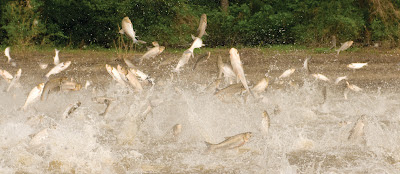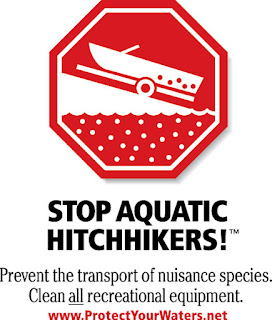“The Asian Carp Regional Coordinating Committee plans to spend $12 million this year on efforts to stop the voracious eaters from reaching Lake Michigan, where scientists fear they could out-compete native fish for food and wreak havoc on the Great Lakes fishing industry. Plans include sampling urban fishing ponds, surveying fish markets for live fish and random electrofishing and netting along a network of canals that connect Lake Michigan to the Illinois River.McCloud said the DNR will visit bait shops and fish markets to make sure there are no live carp, and will sample around 20 lagoons. He said anyone who nets an Asian carp should get it out of the water and make sure it’s dead. He also asks that they take a photo of the fish and call the DNR.”
Category:
In the news: Increasing Asian Carp surveillance for the season
May 29th, 2012 by Irene MilesInvasive fish could be a food solution for Haitians in need
May 10th, 2012 by Irene Miles Sometimes, what can be considered a problem in one area of the world might prove to be a solution to a problem somewhere else on the globe. One such case is the use of Asian Carp as a high-protein food source for Haitian children impacted by the devastating earthquake in January of 2010.
Sometimes, what can be considered a problem in one area of the world might prove to be a solution to a problem somewhere else on the globe. One such case is the use of Asian Carp as a high-protein food source for Haitian children impacted by the devastating earthquake in January of 2010.
“Some innovative thinking is now turning the problem fish into a high-quality protein source for the children at Zanmi Beni, run by Operation Blessing International. Researchers at NOAA’s Louisiana Sea Grant program and the Louisiana State University (LSU) AgCenter have successfully produced canned Asian carp pleasing to the Haitian palate. Ultimately, the product could deliver high-quality protein to people in need, be a boon to fishermen, provide a new opportunity for canneries, and reduce the population of an unwanted invasive species.”
Louisiana Sea Grant Fisheries Specialist Julie Anderson attended IISG’s Asian Carp summit and was able to network with several people including Carol Engle of the University of Arkansas. Carol’s work had involved developing a USDA-approved process for canning Asian Carp, making it possible to safely prepare, store, and ship the food where it was needed.
New Discovery Grant projects – Green infrastructure, pharmaceuticals, and more
May 9th, 2012 by Irene MilesMuch like a gardener hopes that the seeds they plant will eventually bloom into a lush garden, Illinois-Indiana Sea Grant awards Discovery Grants, or “seed” grants, to a number of projects in the hopes that the initiatives will grow into something larger. In recent years, IISG has funded 35 projects focused on key concerns the program is committed to address; here are six new projects for 2012:
May is Illinois Invasive Species Awareness Month
May 7th, 2012 by Irene MilesNow is the perfect time to get people involved in the work of preventing the damage they can do right here in Illinois.
In addition to the links above, don’t forget to visit our Clean Boats, Clean Waters web page for simple and useful ways that boaters can join in the fight to prevent invasive species from spreading. You can also find information on how to volunteer for our Clean Boats Crew and provide in-person advice and tips at local boat ramps and marina.
IISG reaches hundreds at National Science Teacher Association Conference
April 10th, 2012 by Irene MilesIISG Associate Director for Education Robin Goettel, Education Specialist Terri Hallesy, AIS Specialist Sarah Zack, and AIS Assistant Danielle Hilbrich attended the National Science Teacher Association’s 2012 Conference March 29-31, and got a tremendous response to the educational resources, tips, and information they offered to the many teachers in attendance.
Visitors learned about how the “Nab the Aquatic Invader” website can be used as an excellent learning tool for grades 4-10, and how the GLRI “Stop Aquatic Hitchhikers” education and outreach initiative informs people what they can do to prevent the spread of aquatic “hitchhikers.” They also distributed brochures on Great Lakes Literacy principles, and CD-ROM copies of the COSEE/Sea Grant “Fresh and Salt” curriculum on important Great Lakes and marine issues.
The “Don’t Let It Loose” poster contains helpful information for teachers about properly disposing of unwanted classroom organisms. Smaller “tip-card” versions of the poster were available too, as well as an adoption pledge containing care tips for students and their families to use when adopting a classroom organism. Some of the highlights at the IISG table were the specimens available for teachers to look at, including a zebra mussel-encrusted shoe, which was a great catalyst to engage teachers in conservation about invasive species.
Recent News
- IISG’s Eliana Brown wins 2025 Illinois Extension Excellence Award
- We’re hiring eight interns for summer 2026
- In 2026, IISG intends to fund 10 research projects focused on coastal concerns
- IISG looks back on 30 years of AIS outreach
- New step-by-step guide and veterinary brochures expand UnwantedMeds.org resources
IISG Instagram
🌊 Save the Date! 🌊
Shipboard Science Immersion 2026
Join the Center for Great Lakes Literacy aboard the R/V Lake Guardian on Lake Superior, July 7–14, 2026!
✅ Open to formal & nonformal educators (grades 5–12) across the Great Lakes region.
📅 Applications open January 2026
Learn more: https://cgll.org/signature-program/r-v-lake-guardian-shipboard-science-immersion/ or the link in bio.
#TeachingTuesday

Join the Invasive Crayfish Collaborative for an exciting webinar featuring Dr. Chris Taylor from the Illinois Natural History Survey who will provide an overview of midwestern crayfish habitat requirements, feeding, reproductive biology, and life-history.
Crayfishes in the Midwest occupy almost every type of aquatic and semi-aquatic habitat in the region. They function as critically important components of those ecosystems and in many cases represent a majority of invertebrate biomass. As “keystone” species, understanding their biology and roles in ecosystems is critically important.
Register for the webinar at InvasiveCrayfish.org/events1 Or the link in bio.

This season, let’s teach eco-friendly habits while spreading cheer! NOAA’s Greener Holiday Gift Guide is full of ideas to reduce waste and protect our precious water resources.
Check out the full guide at the link in bio.
#teachingtuesday
NOAA Marine Debris
NOAA Education

The gales of November may come early, but, as usual, the nominations for the Lakies are right on time along with our official call for nominations!
Brought to you by the Teach Me About the Great Lakes podcast, The Lakies (aka "quite possibly not the least prestigious Great Lakes-focused awards ceremony there is”) are back.
Our goal isn`t to be the Official Arbiters of Quality, but to host a fun celebration of amazing Great Lakes-related research, outreach, and communication in the inimitable Teach Me style.
Nomination categories are:
-Great Lakes Science Communication of the Year
-Great Lakes Outreach Program of the Year
-Great Lakes News Event of the Year
-Great Lakes Research Finding of the Year
-Coolest Thing You Learned Listening to TMATGL in 2025
-Science Podcast of the Year (Non-TMATGL edition)
-Great Lakes Animal of the Year
-Great Lakes Non-Animal of the Year
-Great Lakes Sandwich of the Year
-Great Lakes Donut of the Year
The Details:
-Deadline: Nominations close on December 4th.
Process: It`s easy (just enter the name/title and a link).
-Self-Nominations: Highly encouraged. Don`t be shy.
We’d love to get a broad swath of work across both the serious and less-serious categories to celebrate. Feel free to pass the link on to interested people: https://bit.ly/Lakies25

Categories
- Aquaculture
- Aquatic Invasive Species
- Buoys
- Climate Ready Communities
- Coastal Resilience
- Director's Blog
- Education
- Featured
- Fellowships
- Fisheries
- Funded Research
- Funding
- Great Lakes Cleanup
- Great Lakes Data
- Healthy Waters
- Internships
- Jobs
- K-12 Education
- News
- Photos
- Program
- Recreation & Tourism
- Resources
- Sea Grant Scholars
- Stormwater & Green Infrastructure
- Sustainable Community Planning
- The Helm
- Uncategorized
- Video
- Water Resource Economics

